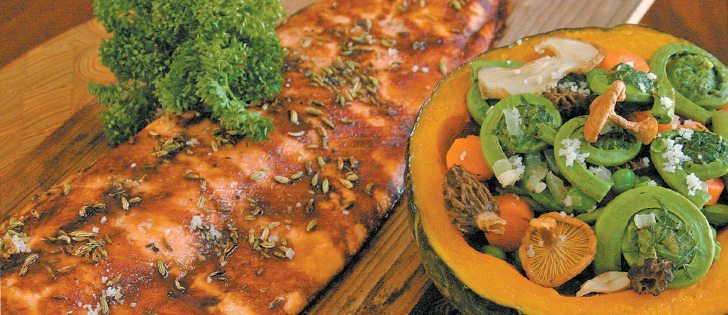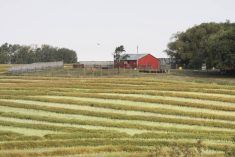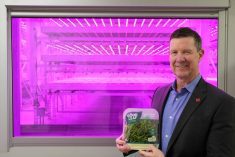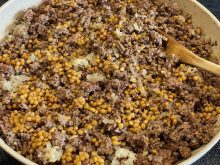I have spent the past year searching for interesting Canadian grown and produced food.
Demand for these products has grown in recent years and that trend is likely to continue.
I’ve explored sea salt from Vancouver Island, garlic from Yorkton, Sask., garlic and foraged wild food from Love, Sask.
Vancouver Island Salt Company (www.visaltco.com), located in the Cowichan Valley, produces the only Canadian fleur de sel.
Founder, owner and former chef Andrew Shepherd is self taught and makes infused salts as well as the basic sea salt.
Read Also

Nutritious pork packed with vitamins, essential minerals
Recipes for pork
He is currently working on a blue cheese infusion and a mandarin orange and lime salt.
He was chosen as one of 20 food artisans for the Ace Artisan Incubator on the Food Channel.
His company relies on word of mouth to sell its products. Ninety-five percent of the fuel used to evaporate the saltwater comes from recycled vegetable oil.
In Yorkton, I met Anna and Darrel Schaab of The Garlic Garden (yorktongarlic.com) while they were harvesting scapes.
Scapes are curly shoots that grow from the garlic stalk and must be removed so the heads develop fully. They have wonderful flavour and are also used in cooking.
The Schaabs purchased a small farm but couldn’t make it work with traditional grain farming. A local garlic grower suggested they grow garlic and taught them what they needed to know.
In the fall of 2005, they planted their first crop. They sell about 200 pounds of garlic per day at the Saskatoon Farmers’ Market and also sell in Regina. In addition, they produce a variety of garlic products.
They mainly grow a hard neck variety called Music.
Prairie Infusions (www.prairieinfusions.com) in Love, Sask., is an unusual business.
The company website says it specializes in the wild harvest of non-timber forest products in Saskatchewan.
Owner and founder Elisabeth Poscher, a University of Arizona trained scientist, was still foraging in the winter for balsam poplar buds and chaga, a rare type of mushroom. Then she moves to tapping maple and birch trees.
“I am fascinated, almost obsessed, by drylands such as the Prairies, and Saskatchewan for me was love at first sight. I’ve made my passion my business while at the same time making my tiny contribution to a more peaceful and healthy world,” said Poscher.
She uses flora and fungi identification literature, herbaria, libraries, maps, microscope and spore prints as research tools in her quest, and she applies her expertise.
Fiddleheads are the unfurled fronds of the ostrich fern and get their name because they resemble the head of a fiddle.
They are foraged in cool, moist forest areas during late April and May. They have a delicate green flavour and are best served simply with butter or olive oil, a sprinkling of sea salt and a squeeze of lemon. Use with pastas, quiche or omelets.
They are an excellent source of beta carotene, niacin and vitamin C and are low in fat and calories.
According to Health Canada, fiddleheads must be cooked before eating. Steam or boil until crisp tender and serve hot or chill in ice water to use in salads.
They can be frozen by blanching for two minutes, chilling and draining well before packing into freezer bags.
Several varieties of wild mushrooms are foraged in late summer and early fall, but because they have a short shelf life, the mushrooms are dried. The flavour is intensified and they need to be reconstituted in liquid before using.
Vegetable Ragout
- fiddleheads
- 1 small squash
- carrots, sliced into rounds
- shelled fresh peas
- unsalted butter
- shallots
- thyme sprigs or dried thyme
- 1 bay leaf
- dried wild mushrooms
- reserved mushroom broth
- garlic, minced
- sea salt
- freshly ground black pepper
Use what you like best and estimate one cup (250 mL) per person. Leftovers can be refrigerated.
Cut squash in half and scoop out seeds.
Spray lightly with oil, season with sea salt and place cut side down on a baking sheet. Bake at 350 F (175 C) for 25 minutes or until fork tender. Set aside.
Hydrate dried mushrooms in boiling water for at least 20 minutes. Reserve the water to use in this recipe.
In a large heavy skillet, combine butter, shallots, garlic, thyme, bay leaf, roughly chopped mushrooms, broth and salt and pepper to taste.
Simmer the mixture, uncovered, for five minutes to reduce if there is too much liquid.
Add fiddleheads, carrots, peas and more broth or water if necessary.
Simmer mixture, for one minute. Discard the bay leaf and season with salt and pepper. Serve in baked squash.
Cedar Planked Steelhead Trout with Birch Syrup
- cedar plank
- fillet of salmon, steelhead trout or Arctic char, skin on
- olive oil
- birch syrup
- sea salt
- fennel
- poplar buds or juniper berries, optional
Soak plank overnight.
Preheat oven to 425 F (215 C). With a mortar and pestle, grind sea salt, fennel and poplar buds or juniper berries.
Pat fillet dry with paper towels. Rub with olive oil and season with salt mixture, then drizzle with birch syrup. Refrigerate for 30 minutes.
Meanwhile preheat plank in oven until smoking hot. Brush with olive oil.
Lay marinated salmon, skin side down, on plank. Return to hot oven and bake about 10 minutes per inch or until almost cooked to medium in the thickest part. Do not overcook. It will continue to cook after removing from oven. Salmon cooked medium is moist, tender and full of flavour.
This can also be done on the barbecue using the same procedure. Don’t worry if the plank smoulders because the smoke will add another dimension to the flavour.
Sarah Galvin is a home economist, teacher and farmers’ market vendor at Swift Current, Sask., and a member of Team Resources. She writes a blog at allourfingersinthepie.blogspot.ca. Contact: team@producer.com.

















